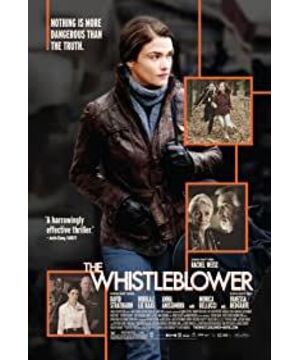First, we can see some traditional exhibitionist female characters in this films which was affected by 'to-be-looked-at-ness' which comes from old style Hollywood films. This movie is about Kathryn Bolkovac (Rachel Weisz) a female cop, who worked as a peacekeeper. At one time, she knew Laura Leviani (Monica Bellucci), a girl who looked like she was abused by someone. When Kathryn tried understanding and helping Laura more, unexpectedly she uncovers an extremely brute human trafficking ring. Lots of girls who like Laura were persecuted. While work in Kathryn gathered evidence to trying to save these girls and reveal those traffickers. She found some photos which recorded how these girls had been abused during their 'works'. The camera uses a close-up shot to show these photos.This is a typical example of female characters in an exhibitionist role who were looked at by spectators in film narrative. Their appearance is coded in a erotic way to gain audiences' gaze and let them enjoy visual pleasure. It is the same as most of the classical Hollywood films. In Mulvey's essay, she also gives several example of female characters' exhibitionist role, 'from pin-ups to strip-tease, from Ziegfeld to Busby Berkeley'(Mulvey, 11). Whatever classical Hollywood films or contemporary films, the 'to-be-looked-at-ness' affects female characters in an exhibitionist role and the way of their looks are always affect spectators' eyes.It is the same as most of the classical Hollywood films. In Mulvey's essay, she also gives several example of female characters' exhibitionist role, 'from pin-ups to strip-tease, from Ziegfeld to Busby Berkeley' (Mulvey, 11). Whatever classical Hollywood films or contemporary films, the 'to-be-looked-at-ness' affects female characters in an exhibitionist role and the way of their looks are always affect spectators' eyes.It is the same as most of the classical Hollywood films. In Mulvey's essay, she also gives several example of female characters' exhibitionist role, 'from pin-ups to strip-tease, from Ziegfeld to Busby Berkeley' (Mulvey, 11). Whatever classical Hollywood films or contemporary films, the 'to-be-looked-at-ness' affects female characters in an exhibitionist role and the way of their looks are always affect spectators' eyes.affects female characters in an exhibitionist role and the way of their looks are always affect spectators' eyes.affects female characters in an exhibitionist role and the way of their looks are always affect spectators' eyes.
Although, female characters' 'to-be-looked-at-ness' in contemporary films helps spectators gain pleasure on visual, sometimes when they use erotic ways to gain audiences' attention, it's inharmonious or too straightly cut into the film narrative. Part of The Whistleblowers connects female characters and film narrative perfectly. For instance, there is a shot describing girls who are in human trafficking working in a bar ,and they are waiting for people to offer money for sexual favors. This shot combined two levels of female characters' function very well: they are not only as a erotic object for characters in films, but they are also as an erotic object for audiences. However, some shots of this film doesn't connect these two functions well. A typical example are the photos we discussed in the last paragraph.Static and isolation of a photo destroy a vivid screen story. When Mulvey described this phenomenon she said 'It gives flatness, the quality of a cut-out or icon rather than verisimilitude to the screen'(Mulvey,12). We can learn form these two parts of film, this is a risk to using female characters 'to-be-looked-at-ness' . It affects a quality of contemporary films particularly.
Contemporary film evolves to a kind of film that only females as the main character, due to the 'to-be-looked-at-ness' of female characters. For instance, Resident Evil, Wanted(2008) and The Whistleblower all belong to this kind of films. They are different from traditional classic Hollywood films in which the male character control the development of the world in screen story. According to Mulvey's article 'visual pleasure and narrative film', we realize 'as the spectator identifies with the main male protagonist, he projects his look on to that of his like, his screen surrogate'(Mulvey, 12). It looks like male spectators don't have their 'screen surrogate in these kind of films. On the other hand, I think spectators enjoy female characters more direct in The Whistleblower,because they control female characters in another way. Kathryn's boss suspended her, because she discovered he and his colleagues were involved in human trafficking. Kathryn also trying to help those girls get out of human trafficking but Laura was killed by the traffickers. During female characters ' life gradually becomes more and more difficult. Girls who was trafficked also give spectators a sense of superiority. Spectator doesn't identification with main male, but he does identification with the lose of female characters and participation in a object which is have the most power that can control female characters' life in the screen story, then indirectly possess her.Kathryn also trying to help those girls get out of human trafficking but Laura was killed by the traffickers. During female characters' life gradually becomes more and more difficult. Girls who was trafficked also give spectators a sense of superiority. Spectator doesn't identification with main male, but he does identification with the lose of female characters and participation in a object which is have the most power that can control female characters' life in the screen story, then indirectly possess her.Kathryn also trying to help those girls get out of human trafficking but Laura was killed by the traffickers. During female characters' life gradually becomes more and more difficult. Girls who was trafficked also give spectators a sense of superiority. Spectator doesn't identification with main male, but he does identification with the lose of female characters and participation in a object which is have the most power that can control female characters' life in the screen story, then indirectly possess her.but he does identification with the lose of female characters and participation in a object which is have the most power that can control female characters' life in the screen story, then indirectly possess her.but he does identification with the lose of female characters and participation in a object which is have the most power that can control female characters' life in the screen story, then indirectly possess her.
The castration anxiety not only exists in classic Hollywood film, but it also affects contemporary films. The reason is sexual differences always exist. Female characters were looked at by spectators, their no penis bodies remind spectators a threat of castration. Thus Mulvey discussed two ways to escape from this castration anxiety. We can see the first way 'voyeurism' in The Whistleblower clearly. Photos which record the way people abused girls and some shots which between trafficker and those girls. They all contain violence and erotic and reflect a way how voyeurism and sadism combined to release anxiety. The Whistleblower is a reflex of real world and an eye opener. We can assume one of the reasons people are involved in human trafficking is not only for money,but it also because sadism and voyeurism which aroused by castration anxiety. They gain comfort from the process of destroying women's bodies. The second way to avoid castration anxiety is fetishistic scopophilia, this is what we talk about in last paragraph. Spectators would like to immerse in diegesis, share the same point of view with main male and possess the female character indirectly.
Altogether, the 'to-be-looked-at-ness' of female characters in classic Hollywood films which was discussed by Laura Mulvey in her essay 'Visual Pleasure and Narrative Cinema' also exists in contemporary films and has unshakable status. Most female characters are passive but important. 'To-be-looked-at-ness' of them affects desire of spectators, the coherence of a film. It controls narrative structure and arouses the concealable castration anxiety. The effects of 'to-be-looked- at-ness' is going to continue to exist in narrative film from now and into the future. Please forgive me for not
writing an essay at school enough..
View more about The Whistleblower reviews











